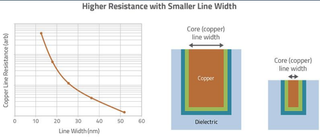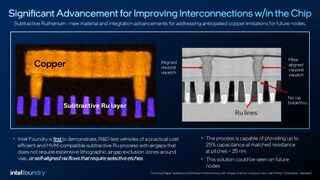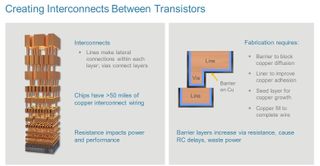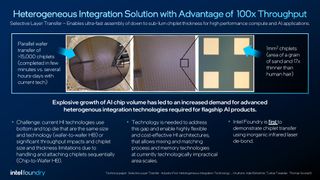Intel looks beyond silicon, outlines breakthroughs in atomically-thin 2D transistors, chip packaging, and interconnects at IEDM 2024
Smaller, faster, better.

Today, the Intel Foundry Technology Research team announced technology breakthroughs in 2D transistor technology using beyond-silicon materials, chip interconnects, and packaging technology, among others. The company will unveil its research in seven of its own papers, along with two more papers in collaboration with industry partners like imec, at the IEEE International Electron Devices Meeting (IEDM) 2024 conference.
Intel’s disclosures include new research that enhances gate-all-around (GAA) transistor scaling and performance both with silicon and with atomically-thin 2D transistors that use beyond-silicon materials. Intel also outlined its subtractive Ruthenium technology that improves interconnect performance and scalability, ultimately enabling smaller wires between transistors, and a chip packaging breakthrough that improves chip-to-chip assembly throughput by 100x.
Intel’s Technology Research team, formerly known as the Components Research team for the last 50 years, is part of Intel Foundry. This team works on developing products intended for commercialization in the nearer term than the more far-looking initiatives at Intel Labs. The Technology Research team is known for paving the way for many of Intel’s fundamental technologies, with the latest innovations like the PowerVia backside power delivery and RibbonFET gate-all-around architecture originating in this group.
Intel hasn’t presented the papers at IEDM yet, and our one-on-one discussion with the General Manager of the Research Team isn’t until tomorrow. We’ll provide the descriptions of the breakthroughs below, but we’ll circle back with an update to fill in more details.
Interconnect scaling breakthough
As transistors get smaller, so too must the wires (interconnects) that connect them. Copper is the material of choice for the billions of nanometer-scale wires that move power and data around inside the chip in a complex 3D grid (you can see what this looks like in this video). In fact, up to 50 miles of interconnect wiring are inside modern chips. However, the ability to shrink these microscopic wires is running out of steam, and most alternatives aren’t suitable for high-volume manufacturing. This is a critical roadblock to moving forward to smaller process nodes.

Much like a standard copper wire you use in your home for electrical devices, the wires that carry electrons between transistors need an insulator, in this case, a dielectric coating, to prevent the electrons from going places they shouldn’t. However, the wires also require a barrier to prevent copper diffusion that could contaminate the dielectric. This barrier creates issues with shrinking the wires.
Shrinking the interconnect wires in a processor is exceedingly difficult because of the requirements of copper damascene, an additive process used to create the wires. First, a trench is created, then a barrier is deposited in the trench on top of a dielectric. A seed layer is then placed on top of the barrier to enable copper electroplating; then, copper is deposited on top. Any excess material at the top is then polished away.
Stay On the Cutting Edge: Get the Tom's Hardware Newsletter
Get Tom's Hardware's best news and in-depth reviews, straight to your inbox.
As shown in the image above, decreasing the amount of copper helps to thin the wire, but it also decreases the ratio of the copper (bulk) to the barrier and seed layer, and resistivity increases exponentially as the wires are shrunk. This means the wires carry less current, slowing the device speed (among other effects) and impacting capacitance.

Intel’s Technology Research team has developed a process suitable for high-volume manufacturing that uses Ruthenium instead of copper. It also features air gaps.
Air gaps are a technology that Intel introduced back in the 14nm process node. This technique removes sections of the insulative dielectric, leaving air instead (air has a dielectric constant of around 1.0) to reduce capacitance (Intel claimed a 17% improvement in capacitance with 14nm).
Intel hasn’t shared the deep dive details of its Subtractive Ruthenium process, but we’re sure to learn more details during the presentation. Intel says its Subtractive Ruthenium process with airgaps provides up to 25% capacitance at matched resistance at sub-25nm pitches (the center-to-center distance between interconnect lines). Intel says its research team “was first to demonstrate, in R&D test vehicles, a practical, cost-efficient and high-volume manufacturing compatible subtractive Ru integrated process with airgaps that does not require expensive lithographic airgap exclusion zones around vias, or self-aligned via flows that require selective etches.”

Intel envisions using this technique for the most critical layers with the smallest pitches at first, while standard copper damascene will be used for the larger upper layers. Naturally, Rutheniuem will also be beneficial for its PowerVia backside power delivery. In the end, these smaller wires will enable connecting to smaller transistors, and Intel says this tech will likely be used in future Intel Foundry nodes.
Gate-All-Around (GAA) transistor breakthroughs



Intel’s RibbonFET is its first new transistor design since FinFET arrived more than 13 years ago. It is Intel’s first gate-all-around (GAA) transistor, debuting with the 20A and 18A nodes. It features stacked nanosheets surrounded entirely by a gate, as opposed to the fins surrounded on three sides used for FinFET.



Now, the challenge is to shrink the GAA designs further, and Intel is tackling that in both standard silicon designs and using new 2D materials. With standard silicon, Intel’s transistor disclosures show enhanced gate-all-around RibbonFET CMOS scaling, resulting in a gate length of 6nm and a nanoribbon/nanosheet thickness of 1.7nm while delivering improved short channel effects and higher performance.
On the first side, the gate length vs electron velocity graph on the right shows an impressive profile. The table in the center of the slide shows comparisons to existing transistor technologies, with the Tfin/Tsi (fin thickness/nanoribbon thickness) for the nanoribbon being nearly twice as thin as the fin used in FinFET.
The biggest question is, what’s next after silicon? After CFET transistors arrive, the next step of GAA is to change the materials used in NMOS and PMOS transistors to 2D materials (only a few atoms thick). The second slide outlines Intel's advances using atomically thin transition-metal dichalcogenide (TMD) materials, widely thought to be the materials used after silicon.
Intel fabricated 2D gate-all-around NMOS and PMOS transistors with a gate length of 30nm using moly-based material. Intel claims this effort delivered ‘best in class NMOS drive currents,’ a 2X improvement over the next-best published result. The chart on the right shows the research vehicle outperforming other such exploratory efforts into TMDs.
Intel’s transistor track also includes a view back at the last 60 years of transistor tech and a call to action for the industry to develop transistors that operate at ultra-low Vdd (supply voltages) of sub-300mV, a substantial decrease from today’s 1V range. This is a stretch goal for the 2030s and 2040s.
Packaging breakthroughs

Intel's new Selective Layer Transfer (SLT) tech enables attaching an entire wafer of chip dies to another wafer at extremely high speeds —Intel says SLT enables a 100X increase in throughput for the chip-to-chip assembly process. With SLT, the entire wafer full of dies can be connected to the underlying wafer at once, and individual dies can be selected for bonding while others can be excluded. This tech uses inorganic infrared laser debonding.
Intel also cites that SLT "enables ultra-thin chiplets with much better flexibility to enable smaller die sizes and higher aspect ratios versus traditional chip-to-wafer bonding." Intel's descriptions of this new tech aren't entirely clear, so we hope to learn more from the presentation. It appears this would be a great alternative to approaches that use reconstituted wafers. We'll add more detail here once we learn more.

Intel will also have an IEDM-invited talk about tomorrow's packaging solutions. This slide above revealed EMIB-T, which hasn't been disclosed previously. As a reminder, EMIB is Intel's Embedded Multi-Die Interconnect Bridge, a low-latency, low-power, and high-bandwidth interconnect that connects die together.
Intel disclosed that EMIB-T stands for EMIB-TSV. This variant marks the first EMIB implementation that uses TSVs to send the signal through the bridge with TSVs instead of wrapping the signal around the bridge.




At IEDM, Intel will submit seven papers along with two other papers with partners such as imec, Aixtron, and the Tor Vergata University of Rome.
We have time carved out with Intel for follow-up questions, and we'll update this piece with more details soon.

Paul Alcorn is the Managing Editor: News and Emerging Tech for Tom's Hardware US. He also writes news and reviews on CPUs, storage, and enterprise hardware.
-
rluker5 Ruthenium isn't cheap. A quick search gave a price of $575.73 per troy ounce. Although they would probably just use a fraction of a gram per chip, the price would rise if they used a lot.Reply -
steve15180 It's great to announce all of these new ideas, it's a whole different thing to bring these great ideas to productions. Intel 20A anyone?Reply -
bit_user Reply
So, is this only the top layer, or else how is the air pocket protected? Is the resulting die somehow sealed? If not, I'd worry about sensitivity to altitude, humidity, and use in environments with a different gas composition than the atmosphere.The article said:Yes, instead of a physical insulative barrier around the wire to keep electrons moving to the correct places, air is used as the insulator (air has a dielectric constant of around 1.0), which improves capacitance quite a bit as well (Intel claimed a 17% improvement in capacitance with 14nm). -
bit_user Reply
They can't do only implementation or fundamental research. There's a "pipeline" analogy, where new ideas need to be discovered, tested, refined, and evaluated for use in production. These things need to happen many years in advance of when you want to actually use them in volume manufacturing.usertests said:Intel: A PowerPoint Company
If you put 100% of your people on just your current node, then the business will fail as demand for that node slumps, because you haven't been investing in what's next and there's no substitute for doing all of that work in advance. Even working only on the current + next nodes isn't enough time to develop and refine all the ideas necessary to make a competitive node. Competing means having people focused on long-range, medium-range, and refining what's new and next.
Also, this stuff doesn't happen in isolation. There are many equipment, materials, and software suppliers in the ecosystem. Collaborating with them is essential. If Intel doesn't win their mindshare and attention, TSMC, Samsung, Rapidus, and other will. That would leave Intel potentially with a new node but no supply chain or supporting toolchains.
I'd love to have more insight into what happened with that. As the history books get written, Intel 4 and 20A might go down as unfortunate detours and ultimately mistakes.steve15180 said:It's great to announce all of these new ideas, it's a whole different thing to bring these great ideas to productions. Intel 20A anyone?
As internal test nodes, maybe they were justified, but I think there's a lot of work that happens when refining a test node for use in volume production that basically turned out to be wasted effort that could've been better spent on Intel 3 and 18A. -
thestryker Reply
I know pretty much nothing about the most cost effective methods of refinement and whether there's any scale to be had, but it's possible pricing could stabilize if there is scale. Some quick looking found that the costs have already skyrocketed as usage has increased (3-5x increase over the last decade). Seems like HDDs had used it as well so as that market collapsed so did pricing (pre-2013) and it's still not back to the peaks it had then.rluker5 said:Ruthenium isn't cheap. A quick search gave a price of $575.73 per troy ounce. Although they would probably just use a fraction of a gram per chip, the price would rise if they used a lot.
I wonder if the confluence of buying more DUV equipment (covid spike), having to buy all of the EUV equipment, High-NA EUV delays and node delay undermined the strategy. The only way I see it making sense is if you nail them all and then shift to the next node for the next product cycle. I hope this is what's behind the 20A cancelation, but until there's volume 18A I'm not hanging my hat on anything.bit_user said:I'd love to have more insight into what happened with that. As the history books get written, Intel 4 and 20A might go down as unfortunate detours and ultimately mistakes.
As internal test nodes, maybe they were justified, but I think there's a lot of work that happens when refining a test node for use in volume production that basically turned out to be wasted effort that could've been better spent on Intel 3 and 18A. -
thestryker The advances with design are expected, but it has been really interesting to see how rapidly packaging improvements have become as important. Hopefully some of this will pan out on the scale. manufacturing side as that seems to be the biggest problem with a lot of the fabrication breakthroughs.Reply
Part of me wonders if we would be having this shift right now had 450mm wafers happened. -
dehjomz This is all well and good. But when is intel going to deliver a chip based on these designs? As well as a chip that beats the 9800x3d in gaming? Right now Intel is being seen as second best in x86 products. So the design and manufacturing teams need to pull a rabbit out of a hat to tackle AMD (and by extension, TSMC).Reply -
watzupken What is the point if you cannot scale it for sale to make money? Isn’t this like Samsung where they kept marketing GAA and whatever XXnm, but no customer because the yield is too poor. It’s all on paper, but can’t make it to the market.Reply -
bit_user Reply
The packaging improvements seem like they could probably apply to products the soonest, which I'd guess might be as early as 2026 or 2027. The wire/insulator improvements seem probably like an intermediate-range thing that could probably apply to the node after 14A. The planar transistor might be even further off.dehjomz said:This is all well and good. But when is intel going to deliver a chip based on these designs?
They claim to be delivering new microcode that should improve gaming performance on Arrow Lake, but I wouldn't count on it beating the 9800X3D. So, that means you'll probably have to wait at least until Nova Lake. However, Bartlett Lake (a Raptor Lake derivative) should launch in Q1 and could turn out to be a better gaming CPU than even Arrow Lake with updated microcode.dehjomz said:As well as a chip that beats the 9800x3d in gaming? Right now Intel is being seen as second best in x86 products.
Intel's next node is called 18A and Nova Lake is supposed to use it. So, they're working on it.dehjomz said:So the design and manufacturing teams need to pull a rabbit out of a hat to tackle AMD (and by extension, TSMC).
Most Popular






